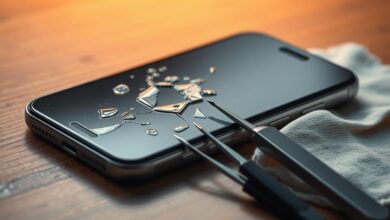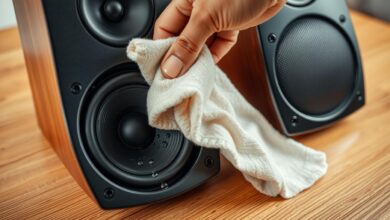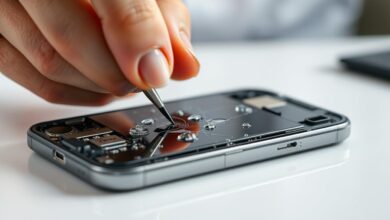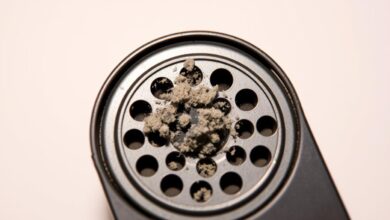how to get water out of your speaker
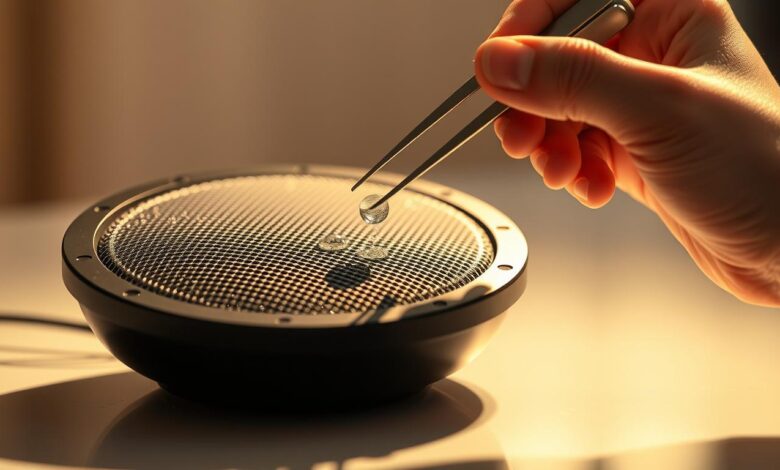
Water damage can really hurt your electronic devices, like speakers. When water gets into a speaker, it can stop it from working right or even break it. It’s important to know how to get water out to save your device.
I’ll show you how to fix your speaker if it gets wet. We’ll cover the dangers, what to do right away, and some DIY fixes to get it working again.
Key Takeaways
- Act fast to lessen the damage.
- Simple DIY tricks can work well.
- Knowing your speaker’s design helps a lot.
- Preventing water damage is the best way.
- Some fixes might take time and a few tries.
Understanding Speaker Water Damage
Water damage in speakers can harm their internal parts. Knowing how water affects speakers is key to fixing them. There are many reasons why water damage happens, and knowing these can help prevent it.
How Water Affects Speaker Components
Water can damage a speaker’s inside parts. This damage goes beyond the outside and affects the speaker’s core.
Impact on Electronic Circuits
Speakers’ electronic circuits are very sensitive to water. Water can create short circuits, causing problems or failure. The corrosion of circuit boards is a big issue, often needing a lot of repair or replacement.
Damage to Speaker Membranes
The speaker membrane is also at risk from water. Water can make the membrane warp or become brittle, affecting sound quality. In bad cases, the membrane might need to be replaced to fix the speaker.
Common Causes of Water Damage in Speakers
Knowing why water damage happens can help prevent it. Several situations can lead to water damage in speakers.
Accidental Spills
Accidental spills are a common cause. Liquids can spill on speakers, especially where food and drinks are around.
Rain and Humidity Exposure
Speakers exposed to rain or high humidity can also get damaged. Speakers used outside or in humid places are more likely to suffer damage.
Bathroom and Pool Incidents
Speakers near bathrooms or pools are at higher risk. Water splashing or condensation can cause damage over time.
Assessing the Severity of Water Damage
Water damage to speakers can be a big problem. It’s important to figure out how bad it is to find a speaker water damage solution. The damage’s extent decides if you can fix it or if it’s too late.
Signs Your Speaker Has Water Damage
First, you need to spot the signs of water damage. Look for these clues:
- Sound distortion or complete loss of sound
- Visible signs of water or corrosion
- Unusual noises or crackling sounds
Sound Distortion Indicators
Distorted sound means water might have gotten inside. Watch for:
- Muffled or unclear audio
- Intermittent sound cut-offs
Visual Inspection Checklist
Looking closely can tell you a lot. Check for:
- Water droplets or moisture inside the speaker
- Corrosion on metal parts
- Damage to the speaker’s membrane or surround
Determining the Extent of Water Exposure
Knowing the type of water and how long it was exposed is key. It helps decide how to dry your speaker.
Fresh Water vs. Salt Water Damage
Fresh water damage is usually less bad than salt water damage. Salt can cause corrosion, making it worse.
Duration of Exposure Assessment
The longer your speaker is wet, the more damage it might have. Quick action is important to reduce damage.
By checking how bad the water damage is, you can choose the right fix. Whether it’s just drying or a big repair, knowing the damage is crucial for a good dry wet speaker fix.
Immediate Actions to Take When Your Speaker Gets Wet
When your speaker gets wet, acting fast is key to avoid lasting harm. The steps you take early on can greatly affect its recovery.
Power Off and Disconnect Immediately
As soon as you see your speaker is wet, turn it off right away. This is your first defense against water damage. Taking it off any power source stops short circuits that could harm it more.
Safe Shutdown Procedures
To safely turn off your speaker, press and hold the power button until it’s off. Don’t force it or press too hard, as this could push water deeper into the device.
Remove Batteries or Power Sources
If your speaker runs on batteries, take out the batteries quickly and carefully. This stops any chemical damage from the batteries mixing with water.
Battery Removal Safety Tips
When taking out batteries, avoid touching any inside parts or wires to prevent more damage. If unsure, check your speaker’s manual for guidance.
Initial Drying Techniques
After turning off and removing power sources, start drying. Gently shake the speaker to remove water from its nooks.
Gentle Shaking Methods
Hold the speaker with the ports down and shake it gently. This helps get rid of water that might have gotten in.
Proper Positioning for Drainage
Place the speaker so water can drain out. For example, if water got in through the top, keep it upright to let gravity help drain it.
By taking these quick steps, you can greatly improve your speaker’s chances of recovering from water damage. Remember, the key is to act fast and carefully to reduce harm.
How to Get Water Out of Your Speaker: Basic Methods
If you’ve accidentally submerged your speaker in water, there are several basic methods to dry it out. Acting quickly is crucial to prevent permanent damage. In this section, I’ll explore effective DIY techniques to dry your speaker.
The Gravity Method
The gravity method is one of the simplest techniques to remove water from your speaker. It relies on gravity to pull the water out.
Optimal Speaker Positioning
To use the gravity method effectively, position your speaker in a way that allows water to drain out easily. For instance, if the speaker is submerged, gently shake it to dislodge any trapped water, then place it with the speaker grille facing downwards. This positioning helps water exit the speaker naturally.
Duration and Effectiveness
The effectiveness of the gravity method depends on the duration you leave the speaker in the optimal position. I recommend leaving it for at least 24 to 48 hours. This timeframe allows any moisture within the speaker to drain out completely. Be patient, as rushing this process can lead to incomplete drying.
Using Absorbent Materials
Another effective method to dry out your speaker involves using absorbent materials. These materials can help soak up moisture from the speaker.
Microfiber Cloth Technique
A microfiber cloth is an excellent tool for drying your speaker. Gently pat the exterior, especially around the speaker grille, to absorb as much water as possible. Avoid rubbing or applying too much pressure, which could push water further into the speaker.
Cotton swabs can be used to dry the speaker grille and surrounding areas. Carefully insert a cotton swab into the grille to absorb water. Be cautious not to push the swab too far into the speaker, as this could cause damage.
Air Drying Techniques
Air drying is another effective method to dry your speaker. This technique involves circulating air around the speaker to evaporate the moisture.
Natural Air Drying
Place your speaker in a dry, well-ventilated area. Let it air dry naturally for a couple of days. This method is safe and effective, although it may take longer.
Using Fans Safely
To speed up the drying process, you can use a fan to circulate air around the speaker. Set the fan to a low or medium setting to avoid blowing debris into the speaker. Position the fan at a safe distance to ensure gentle airflow. This method can significantly reduce drying time.
By applying these basic methods, you can effectively dry out your speaker and potentially save it from water damage. Remember to be patient and gentle during the drying process to avoid causing further damage.
Advanced Techniques for Water Removal
When basic methods don’t work, it’s time to try advanced techniques. These methods are great for serious water damage.
Using Sound Frequencies to Expel Water
One cool method uses sound waves to get rid of water. It works by making sound waves that push water out of the speaker’s small spaces.
Water Eject Tone Explanation
A water eject tone is a sound frequency made to push water out. It’s a sound we can hear and is played through the speaker. This creates vibrations that help move the water.
Frequency Range Effectiveness
The success of this method depends on the sound frequency used. Sounds between 100 Hz to 200 Hz work best because they make strong vibrations.
Specialized Apps for Water Ejection
There are apps that help get water out of speakers using sound. These apps are handy for phone speakers.
Top Apps for iPhone Users
iPhone users have apps like Water Eject and Speaker Cleaner. These apps make the right sounds to remove water.
Best Android Water Ejection Apps
Android users can use apps like Water Eject and Speaker Water Eject. They work the same way, using sound to push out water.
Vacuum Method for Water Extraction
Another advanced method uses a vacuum to pull out water. But, you have to be careful not to damage the speaker.
Low-Suction Technique
It’s best to use a low-suction setting to avoid pushing water deeper or harming the speaker. A gentle suction can safely remove water.
Safety Precautions
When vacuuming, keep a safe distance and use the lowest suction. This helps protect the speaker’s delicate parts.
| Method | Description | Effectiveness |
|---|---|---|
| Sound Frequencies | Uses specific sound waves to expel water | High |
| Specialized Apps | Generates sound frequencies through the phone’s speaker | Medium to High |
| Vacuum Method | Uses suction to draw out water | Medium |
Drying Portable Bluetooth Speakers
When your portable Bluetooth speaker gets wet, knowing the right drying techniques is crucial. Water exposure can lead to significant damage if not addressed promptly and correctly.
Step-by-Step Process for Bluetooth Speakers
Drying your Bluetooth speaker involves a series of careful steps. First, immediately power off the device to prevent any short circuits. Next, remove any accessories or covers to facilitate drying. For many models, gentle shaking can help remove excess water, but be cautious not to cause further damage.
For more thorough drying, you can use absorbent materials like silica gel packets or uncooked rice. Place the speaker in a container filled with the desiccant material, ensuring it’s fully covered, and let it sit for at least 48 hours.
JBL Speaker Drying Methods
JBL speakers, known for their durability, still require careful handling when wet. According to JBL’s guidelines, avoid using heat to dry the speaker, as this can damage internal components. Instead, focus on air drying or using desiccants.
Bose Speaker Recovery Techniques
Bose recommends drying the exterior with a soft cloth and allowing the speaker to air dry. For more severe water exposure, Bose suggests contacting their customer support for further assistance.
Special Considerations for Different Brands
Different brands have varying levels of water resistance. Understanding whether your speaker is waterproof or water-resistant is crucial. Waterproof speakers can withstand being submerged, while water-resistant speakers can handle splashes but may not survive immersion.
Waterproof vs. Water-Resistant Models
Check your speaker’s specifications to determine its level of water protection. This knowledge can guide your drying process and help prevent future damage.
Speaker Grill Cleaning Approaches
Cleaning the speaker grill is an essential step in maintaining your device. Use a soft-bristled brush or a dry cloth to gently remove debris. For more stubborn dirt, a slightly damp cloth can be used, but ensure the speaker is dried thoroughly afterward.
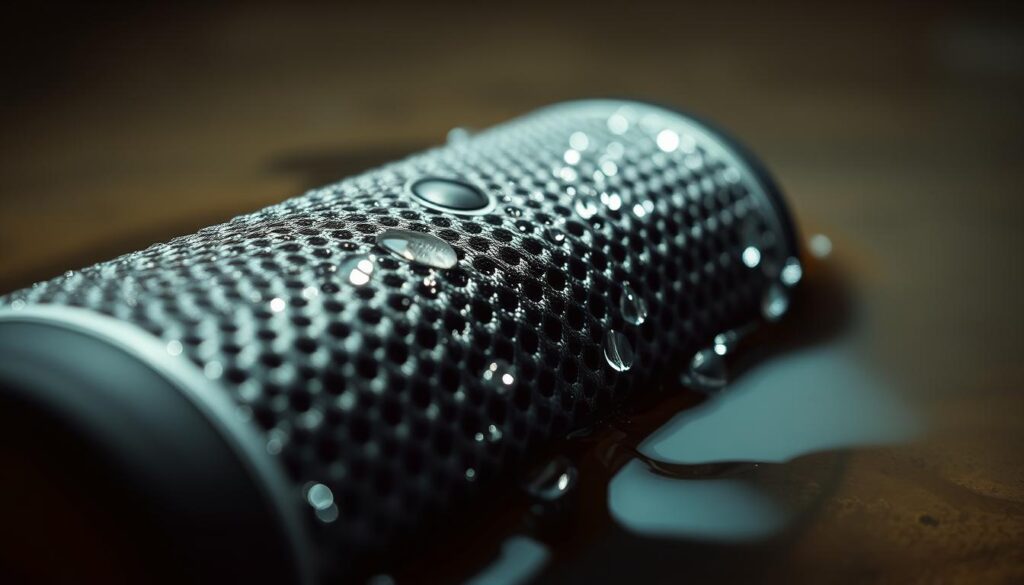
By following these steps and considering the specific needs of your Bluetooth speaker brand, you can effectively dry your device and potentially prevent long-term damage. Remember, the key to successful drying is patience and gentle care.
Removing Water from Smartphone Speakers
Removing water from smartphone speakers can be different for each model and brand. Whether you have an iPhone or an Android, knowing the right steps for your phone is key. This helps you get rid of water effectively.
iPhone-Specific Water Removal Techniques
Apple has made it easier for iPhone users to remove water from speakers. They use shortcuts to help eject water.
Using Shortcuts for Water Ejection
The Shortcuts app can play a sound frequency to push water out of your iPhone’s speaker. It’s a simple yet effective method.
Speaker Cleaning Mode on Newer Models
Newer iPhones have a special feature for speaker cleaning. It uses sound waves to remove water and dirt.
Android Phone Speaker Drying Methods
Android devices, like Samsung and Google Pixel, have their own ways to dry out speakers.
Samsung Water Lock Feature
Samsung phones have a Water Lock feature to get rid of water in the speaker. You can find it in settings or use specific button combinations.
Google Pixel Speaker Drying
Google Pixel phones might use sound frequencies or apps to dry speakers. Check your settings or use a third-party app for help.
Using Built-in Water Ejection Features
Many phones now have built-in features to remove water from speakers. Knowing how to use these can be easy.
Activating Emergency Sound Features
Some devices let you turn on emergency sound features. These high-frequency sounds can quickly get rid of water.
Third-Party Solutions
If your phone doesn’t have built-in features, third-party apps and accessories can help. They might include apps that play specific sounds or drying devices.
Getting water out of your phone’s speakers takes patience and the right method. By using the techniques for your device, you can fix water problems.
Dealing with Water in Larger Audio Systems
Larger audio systems, like home theaters and car speakers, need extra care when water damage happens. These systems are complex and big. Water damage can be serious if not fixed quickly and correctly.
Home Theater Speaker Water Damage Solutions
Home theater speakers, like bookshelf and tower speakers, can get damaged by water. This can happen from spills or too much humidity. First, turn off the system and unplug all cables.
Bookshelf and Tower Speaker Drying
For bookshelf and tower speakers, gently wipe the outside with a soft cloth to remove moisture. Then, put the speakers in a dry, well-ventilated spot. Don’t use heat sources like hair dryers, as they can harm the speakers.
Subwoofer Water Removal
Subwoofers are bigger and have more parts inside. If they get wet, look for any signs of moisture. Let them dry completely before using them again.
Car Speaker Water Removal Techniques
Car speakers, whether in doors or the dashboard, can get damaged by water. The goal is to dry them out fast.
Door Speaker Drying Methods
To dry door speakers, take off any grills or covers to check for moisture. Use a desiccant or uncooked rice to soak up moisture. Make sure there’s good air flow around the speaker.
Dashboard Speaker Recovery
Dashboard speakers need to be taken apart to dry their parts. If you’re not sure how, it’s best to get help from a pro for water damage speaker repair.
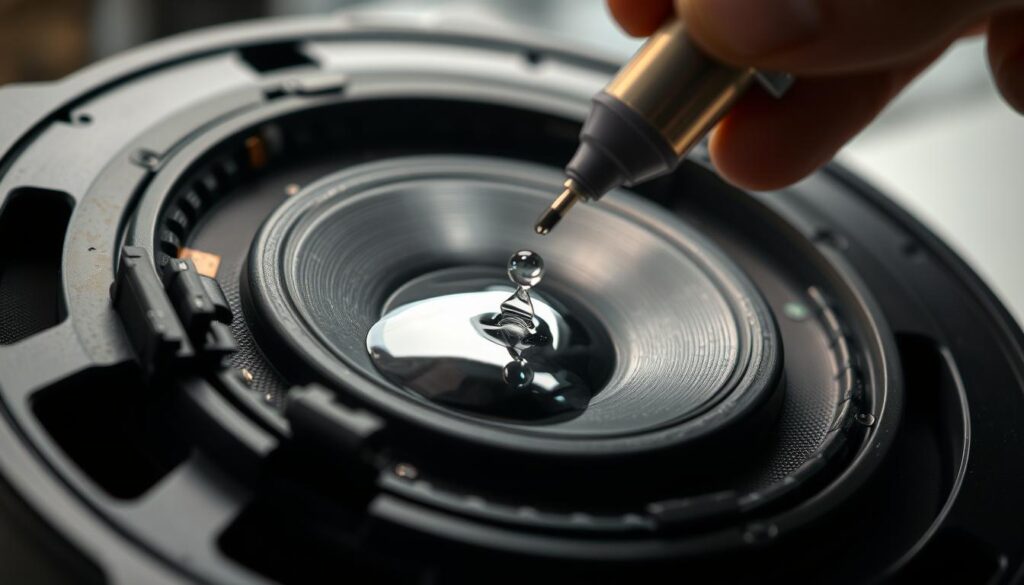
Fixing a waterlogged speaker takes time and the right steps. Knowing your speaker type and using the right drying methods can fix it. For tricky cases or if unsure, getting a pro for speaker water damage fix is a good idea.
Using Desiccants and Dehumidifiers
Drying a wet speaker needs careful steps. Desiccants and dehumidifiers are good options. They help by lowering moisture around the speaker.
Silica Gel and Rice Methods: Do They Work?
Many use silica gel and rice to dry wet electronics. Silica gel is great at soaking up moisture.
Scientific Evidence and Limitations
Studies show silica gel works well against humidity and moisture. But, its power depends on how much you use and for how long. Rice is not as good at drying as silica gel.
Proper Application Techniques
To use silica gel right, put the speaker in a container with it. Make sure the speaker is fully covered. Rice can also help, but it’s not as effective.
Commercial Desiccants for Electronics
There are special desiccants for electronics. They work better than things like rice.
Most Effective Products
- Desiccant packets made for electronics
- Products like Dri-Dek that absorb moisture
Application Duration
How long you use commercial desiccants depends. Usually, 24 to 48 hours is enough.
Using Dehumidifiers Effectively
Dehumidifiers can also help dry wet speakers. They lower the air’s moisture.
Optimal Settings and Distance
For best results, put the speaker near the dehumidifier but not too close. Use a low humidity setting to dry it slowly.
Duration of Treatment
How long you use a dehumidifier depends on the damage. A few days can usually dry the speaker out.
Disassembly and Internal Drying (When Appropriate)
Deciding to take apart a speaker to dry it out depends on several things. This includes how much water got in and the speaker’s design. Not all speakers can be taken apart without risking damage or voiding warranties.
When to Consider Disassembly
Before you start taking apart your speaker, think it over. If your speaker got fully wet or you see a lot of water inside, it might need to be taken apart.
Risk Assessment Factors
Think about the type of water it was (fresh, salt, or dirty) and how long it was exposed. Saltwater, for example, can be more harmful because it’s corrosive.
Warranty Considerations
Look at your warranty. Taking apart your speaker might make your warranty invalid. So, it’s important to think about the risks and benefits.
Tools Needed for Safe Disassembly
To safely take apart your speaker, you’ll need the right tools. A basic set should have screwdrivers, a plastic spudger, and anti-static wrist straps.
Essential Tool List
- Screwdrivers (Phillips and flathead)
- Plastic spudger
- Anti-static wrist straps
Workspace Preparation
Set up a clean, well-lit area for work. Use an anti-static mat on your work surface to protect components.
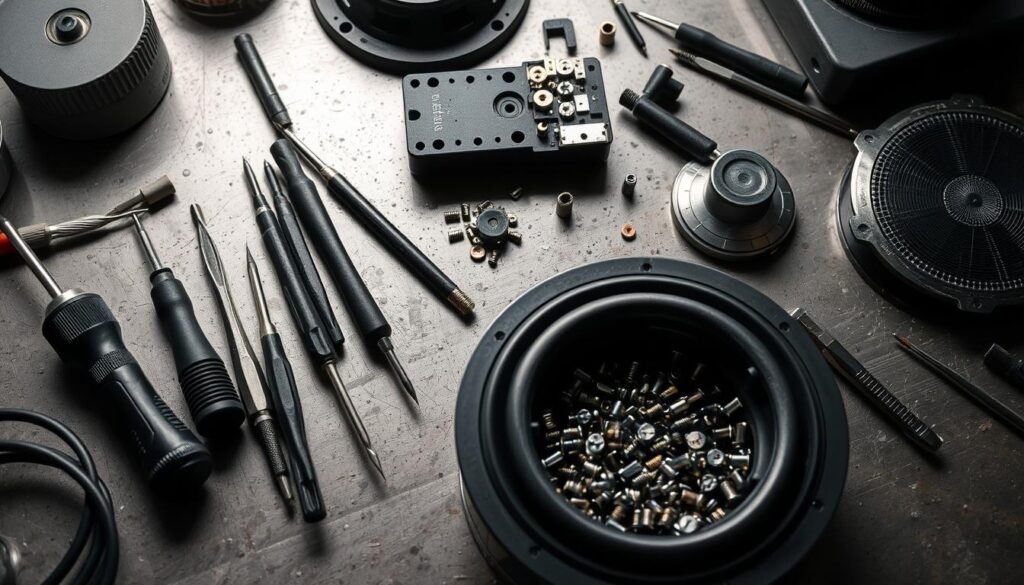
Step-by-Step Disassembly Guide
It’s key to document your steps. Take photos or videos as you take apart the speaker. This will help a lot when you put it back together.
Documentation Techniques
Use a camera or smartphone to take detailed pictures of each step. This will be super helpful when you’re putting it back together.
Component Handling Safety
Always handle components by the edges to avoid touching electrical parts. Use anti-static precautions to prevent damage.
Proper Reassembly Techniques
Once you’ve dried the parts, it’s time to put your speaker back together. Make sure all parts are dry before you start.
Component Drying Verification
Check that all components are completely dry. Any leftover moisture can cause problems when you turn it on.
Testing After Reassembly
After putting it back together, test your speaker at a low volume first. This will help you find any issues.
| Step | Description | Notes |
|---|---|---|
| 1 | Disassemble the speaker | Document the process |
| 2 | Dry the components | Ensure complete dryness |
| 3 | Reassemble the speaker | Follow your documentation |
| 4 | Test the speaker | Start with low volume |
When to Seek Professional Help
Many water damage cases in speakers can be fixed at home. But, there are times when you need a pro. If your speaker still doesn’t work after trying to dry it, it’s time to call an expert.
Signs the Damage Requires Expert Assistance
Some signs show your speaker needs a pro. These include:
- Persistent Audio Issues: If your speaker keeps making distorted sounds or won’t work, it’s too big a problem for you to fix.
- Visible Corrosion Indicators: Corrosion on parts inside is serious. Seeing rust or greenish spots on circuit boards means you need a pro to fix the speaker.
Finding Qualified Repair Services
Looking for a pro to fix your water-damaged speaker? Here are some tips:
- Manufacturer Repair Options: Many makers offer repair services. Check your warranty or call the customer service to see if they can help.
- Third-Party Repair Evaluation: If the maker can’t help or you’re not happy with their offer, look for other shops. Make sure they know how to fix water damage speaker repair and give a fair price.
Expected Costs for Professional Repair
Knowing what repair costs are important. Think about these points:
- Repair vs. Replacement Analysis: Sometimes, fixing your speaker might cost as much as a new one. In that case, getting a new one might be cheaper.
- Insurance Coverage Possibilities: Check if your insurance, like homeowner’s or renter’s, covers accidental damage to your speaker.
Preventing Future Water Damage to Speakers
It’s just as important to prevent water damage to your speaker as it is to know how to dry it out. After dealing with water damage, taking steps to prevent it can save you a lot of trouble.
Waterproof Cases and Covers
Using waterproof cases and covers is a great way to protect your speaker from water damage. These solutions help keep water out of your speaker’s internal parts.
Best Protective Solutions for Portable Speakers
For portable speakers, there are many waterproof cases that fit well. Brands like JBL and Ultimate Ears make stylish and effective waterproof options.
Custom-Fit vs. Universal Options
You can choose between custom-fit and universal waterproof cases. Custom-fit cases are made for specific speakers, offering precise protection. Universal cases work with many devices, giving you more flexibility.
Safe Placement Strategies
Being careful where you place your speaker can also help prevent water damage.
Bathroom and Kitchen Considerations
In places like bathrooms and kitchens, where water is common, keep your speaker away from it. Don’t put speakers near sinks, bathtubs, or showers.
Outdoor Usage Guidelines
When using your speaker outside, be mindful of the weather. Stay away from pools, ponds, and rainy areas. If you must use it outside, use a waterproof cover or speaker.
Waterproof Speaker Alternatives
For a long-term solution, think about getting a waterproof speaker. These speakers are made to handle water, perfect for wet conditions.
IP Rating Explanation
When looking for waterproof speakers, check the IP rating. This rating shows how well the speaker can resist solids and liquids. For example, an IPX7 rating means it can handle being underwater up to 1 meter deep for 30 minutes.
Top Waterproof Speaker Recommendations
The JBL Flip 6 and the Ultimate Ears Wonderboom are top waterproof speakers. They offer great sound and are very waterproof.
Conclusion
Dealing with water in your speaker can be frustrating. But, taking quick action and using the right methods can save your device. We’ve looked at many ways to remove water from speakers, from simple methods to advanced ones.
When fixing a water-damaged speaker yourself, it’s key to check the damage first. Choose the best drying method for your speaker, whether it’s a portable Bluetooth speaker or a smartphone speaker. Knowing when to get professional help is also important to avoid more damage.
By using the strategies we’ve shared, you can get water out of your speaker and prevent future problems. Using waterproof cases or covers and being careful with your speaker’s placement can help a lot. With the right knowledge and precautions, you can enjoy your audio devices without worrying about water damage.
FAQ
How do I know if my speaker has water damage?
Look for signs like distorted sound or crackling noises. Also, check for water droplets, corrosion, or mineral deposits.
Can I use a hair dryer to dry out my speaker?
No, hair dryers can push water deeper or damage components. Instead, use air drying or desiccants.
How long does it take to dry out a water-damaged speaker?
Drying time depends on water exposure and drying method. It can take hours to days for complete drying.
Is it safe to use a wet speaker?
No, using a wet speaker can cause damage or electrical shock. Make sure it’s dry before using it again.
Can salt water damage speakers more than fresh water?
Yes, salt water is more damaging due to corrosion. Salt residue can continue to damage even after evaporation. It’s important to clean and dry thoroughly.
Are there any apps that can help remove water from speakers?
Yes, apps that generate sound frequencies to expel water exist. They work on both iPhone and Android.
How can I prevent water damage to my speakers in the future?
Use waterproof cases or covers. Place speakers away from water sources. Consider waterproof speaker alternatives with a good IP rating.
Should I disassemble my speaker to dry it?
Disassembling is cautious and only when necessary. Assess risk, consider warranty, and follow proper techniques to avoid damage.
When should I seek professional help for water damage?
Seek help if you notice audio issues, corrosion, or are unsure about drying or repair.
Can I repair a speaker that has been damaged by water?
Yes, but success depends on damage extent. For minor damage, DIY drying might work. Severe cases may need professional help or replacement.
